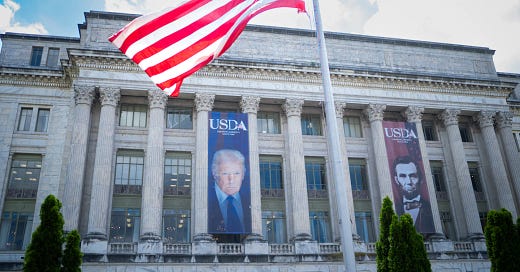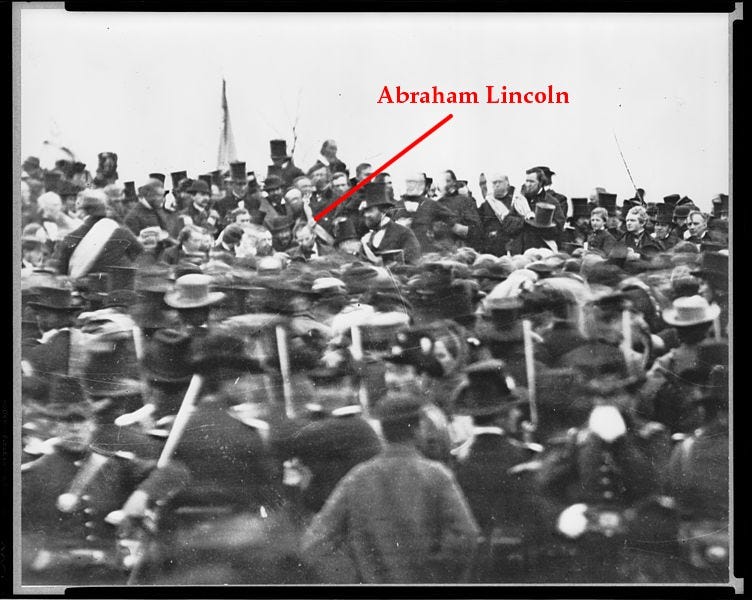Trump and Lincoln on the National Mall
The meaning of the Trump and Lincoln banners on United States Department of Agriculture building
The Jamie L. Whitten Building: On the National Mall Since 1908
The United States Department of Agriculture (USDA) Building, also known as the Jamie L. Whitten Building, at 12th Street and Jefferson Drive, S.W., is the only building on the heavily-visited National Mall not intended for public use. It was the first Beaux-Arts building in Washington and was the prototype for buildings in the Federal Triangle complex. The Whitten Building was listed on the National Register of Historic Places in 1974.
May 2025: The Trump and Lincoln Banners Go Up on the Mall
It was arresting, and fascinating, when two large banners depicting presidents Abraham Lincoln and Donald Trump were installed in May 2025 on the façade of the Whitten Building. Each banner reads “Growing America Since 1862” and commemorates the 163rd anniversary of the USDA’s establishment. A USDA official said that the banners will be up “for the coming months.”
The Lincoln banner shows a familiar late in life image of the 16th president. The Trump banner is the August 24, 2023 booking photograph taken at the Fulton County Jail in Atlanta, Georgia after Trump’s indictment on racketeering and related charges. It is the only police booking photograph of a U.S. president.
The pairing of Trump’s mug shot (as distinct from an official portrait or other image) with Lincoln’s photograph was intentional. Trump’s mug-shot-as-banner simultaneously celebrates his victories in the criminal justice system and aligns him with Lincoln, who is generally accorded a place on any list of the greatest American presidents.
The hanging of the Lincoln and Trump banners together in a prominent place on the National Mall is a visual reminder that in important ways Trump and Lincoln are very different. The following briefly explores their connections and differences.
Trump’s Repeated References to Lincoln
Trump has often compared himself to Lincoln, a fact underscored by the large banners on the Whitten Building.
John O’Connor of the Associated Press picked up on Trump’s self-association with Lincoln in an October 2022 article. O’Connor describes Trump’s Lincoln references as a “recurring refrain in Trump’s unique brand of oratory” and cites this example:
“This is Donald Trump, hopefully your favorite president of all time, better than Lincoln, better than Washington,” Trump said in a video introducing “Trump digital trading cards” in December 2022, shortly after announcing his third run for the presidency.
Plans and Themes for a Second Presidential Term
How Trump and Lincoln began their second terms as president reveals a great deal about each man. Each confronted the challenge of translating an electoral victory into a path forward for governing a very divided nation.
In 1864, Lincoln easily defeated Democrat George B. McClellan in an election conducted only in states that had not seceded from the Union. The nation was exhausted, but it was largely clear by the end of 1864 that the North would win the war. Lincoln’s challenge was how to guide the country through the end of the war and in the post-war period.
Lincoln rejected triumphalism or gloating about the North’s victory. His Second Inaugural Address on March 4, 1865 described common characteristics of the North and South:
Neither anticipated that the cause of the conflict might cease with, or even before, the conflict itself should cease. Each looked for an easier triumph, and a result less fundamental and astounding. Both read the same Bible, and pray to the same God; and each invokes His aid against the other.
The question of what impact Lincoln would have had on the post-Civil War period is one of American history’s great imponderables. There might be a clue in the compassionate and generous way Lincoln ended the Second Inaugural Address by making no distinctions among those who had suffered and died for either side:
With malice toward none; with charity for all; with firmness in the right, as God gives us to see the right, let us strive on to finish the work we are in; to bind up the nation's wounds; to care for him who shall have borne the battle, and for his widow, and his orphan—to do all which may achieve and cherish a just, and a lasting peace, among ourselves, and with all nations.
The complete Second Inaugural Address, which is very short, can be seen
In the daily open firehose of information describing how President Trump has begun his second term it is clear that in many respects—notably his issuance of Executive Orders targeted at universities, law firms, and others—Trump’s approach is nothing like the conciliatory and generous way Lincoln began his second term.
The Consoler-in-Chief
A president’s responsibilities include honoring the memories of those who were injured or killed defending the nation. Trump and Lincoln demonstrate very different approaches to this solemn duty
Here is how The New York Times reported on Trump’s wreath-laying speech on May 26 at Arlington National Cemetery:
In remarks commemorating Memorial Day, Mr. Trump thanked those who had fought in some of the nation’s defining battles, and cited specific stories of sacrifice by soldiers and their families.
“We certainly know what we owe to them,” Mr. Trump said. “Their valor gave us the freest, greatest and most noble republic ever to exist on the face of the earth — a republic that I am fixing after a long and hard four years.”
He also used the occasion, traditionally a solemn day of tributes, to indirectly criticize his predecessor, former President Joseph R. Biden Jr., for his border policies while valorizing his own return to office.
“We’re doing so very well right now, considering the circumstances,” Mr. Trump said. “And we’ll do record-setting better with time. We will do better than we’ve ever done as a nation, better than ever before. I promise you that.”
The complete article can be read
On November 19, 1863, about four and a half months after the battle of Gettysburg and the costly victory of the Union's Army of the Potomac over Robert E. Lee's Army of Northern Virginia, Lincoln traveled to Gettysburg for the dedication of a cemetery for those who had died in the battle.
A noted orator, Edward Everett, a former senator from Massachusetts, was the featured speaker. Everett spoke for about two hours. Lincoln followed with a speech of hardly more than two minutes that defied the florid oratory of the time.
The Gettysburg Address was not universally admired at the time. Historian Shelby Foote has described the sparse applause that followed Lincoln's speech as "barely polite." The Chicago Times, no admirer of Lincoln's, described the address as "silly, flat and dishwatery utterances." Everett was gracious, writing to Lincoln after the ceremony at Gettysburg that, "I should be glad, if I could flatter myself that I came as near to the central idea of the occasion, in two hours, as you did in two minutes."
Lincoln delivered a self-effacing speech at Gettysburg with no description of his priorities or achievements. He intentionally downplayed his role in light of the purpose of the occasion, saying, “The world will little note, nor long remember, what we say here, but can never forget what they did here.”
This photograph, which was not discovered until 1952, is believed to be the only image of Lincoln at Gettysburg. The speculation is that his speech was so short that the photographers present could not get organized to get a picture of him delivering his address.
The complete text of the Gettysburg Address can be seen
A Few Final Words
President Trump should not be denigrated for striving to associate himself with President Lincoln. The more Lincoln is understood for his values and ideals, the better off the nation will be.
The eminent social philosopher, my mother, offered a nuanced understanding when she said, “People do not change as they get older, they get more so.” The Trump-Lincoln comparison, now evident in the banners installed at the Whitten Building, may be an example of people revealing their essential characters more fully as time passed.
Certainly, the Trump of the second term is consistent with the Trump of the first term and what he told us his plans were during the four years he was out of office.
As to Lincoln, he announced the generous and expansive understanding of America shown in his Second Inaugural Address and the Gettysburg Address in the conclusion of his First Inaugural Address on March 4, 1861. As the Civil War became inevitable, Lincoln told America:
I am loath to close. We are not enemies, but friends. We must not be enemies. Though passion may have strained it must not break our bonds of affection. The mystic chords of memory, stretching from every battlefield and patriot grave to every living heart and hearthstone all over this broad land, will yet swell the chorus of the Union, when again touched, as surely they will be, by the better angels of our nature.
Your comments are very welcome.
Thanks for reading About Alexandria!
Subscribe for free to receive new posts.






This is a brilliant combination of current events and the history of our most revered president. The comparisons are telling.
Well done, Mark.
I'm a big fan of everything Mark writes for this forum, but I'm inclined to think this piece is the best one he's written so far. The differences between Trump and Lincoln are so stark. Based on what I've absorbed, particularly from Doris Kearns Goodwin's superb "Team of Rivals," I think the difference boils down to ego. Lincoln did have an ego, but he controlled it. Yes, he was a politician, but time after time Lincoln as President did things that were not necessarily great for him, but were important for the country. Trump (whose ego is off the charts) won't do anything that he thinks won't look great for Trump.